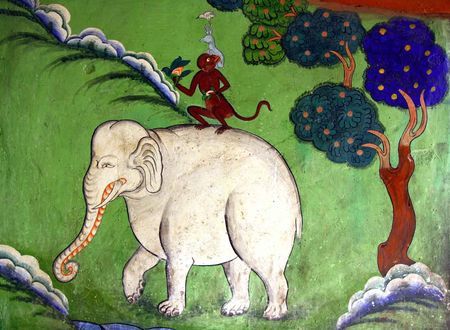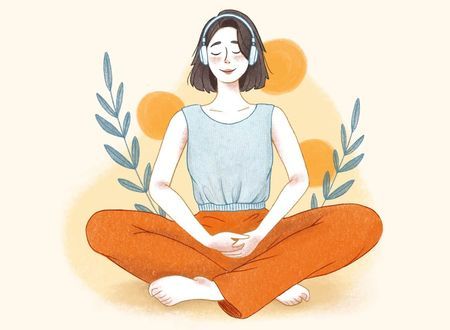Before you start reading this post, let me say at the outset, my write up today may sound dry and boring to those who aren’t into meditation. Plus, it’s much longer than my usual weekly post. Hence, if you are not interested in meditation or its link with various levels of human consciousness, you can safely skip reading this article. I’ve specifically written it for earnest meditators.
Last week, classifying meditators into four types, I promised to elaborate on the nine states of awareness on the path of meditation. Before I dive into the various states, it’s important to understand that fleeting or one-off experiences in meditation should not be confused with attaining a certain level of consciousness. For example, feeling a sensation in your spine or between your brows, or seeing flashes of light or glimpses into your future does not mean a meditator has reached an advanced level (unless you experience it every time you meditate). These experiences have little meaning. They can even be distractions, in fact.
A major part of my 22-year journey of meditation has been focused on establishing a scientific basis for the experiences. If I can’t replicate or reproduce my experience then I don’t really know what caused it. If I don’t know what caused it how do I really know if it was for real and if it can be passed on with conviction. Whether experiencing sensations or gaining control of the involuntary system of our body, if we can’t reproduce it at will, it means we haven’t mastered it yet. If a musician can’t replay the piece whenever she wishes to, she’s not really an expert then. Is she? Consistency in anything comes from correct practice. And, practice is the basis of championing the art of meditation.
Many readers wrote to me that they were alarmed to see the number of hours required to be a keen or intense meditator in my last week’s post. Here’s the thing: I’ve given you the highest ideal, and now, it’s up to you how far you want to go. My job is to tell you the truth. Whenever you think about samadhi or experiencing bliss through meditation, I want you to close your eyes and think about Einstein, Edison, Newton and the like. Just reflect on how many hours they must have devoted to their research to produce groundbreaking theories that they did. Edison practically used to sleep in his lab; he would not come out for days at a stretch. Or, think of a professional pianist. A concert pianist invests an average of 10,000 hours in practice and training before reaching that expert level where playing becomes effortless and natural. Meditation is no different. At least, take the first step. Here’s a ray of light for you though: past the first four states of awareness, you don’t necessarily need to sit down and meditate. You could simply maintain meditative awareness around the clock.
Some readers wrote that it was just impossible to put in the hours I was talking about. I’m amused (not surprised) at how casually we use impossible to say I’m not willing to put in the effort. The truth is it boils down to one’s priorities. If something is your priority, you’ll find the time. And as you advance on the path, I guarantee you, your priorities will change. They will change because you’ll evolve, you’ll grow spiritually, emotionally, mentally and intellectually. Such growth will bring about profound and permanent changes in you. You’ll start to look at the world differently. What matters to you now may not matter in the least then.
Patanjali, Vyasa and other sages, while propounding the path of meditation, listed nine states of awareness. In a way, these states represent the spiritual evolution of an aspirant. Do read my last week’s post on the types of meditators because the subject matter today is a sequel to that.
1. Intellectual Awareness
This is called vitarka pragya. Other than intellect, vitarka also means reasoning and opinion. Pragya means wisdom, knowledge or intelligence. In this state of awareness, intelligence is limited to intellectual analysis at the external level. A mild meditator’s wisdom is often devoid of experiential intelligence and is limited to an intellectual understanding of all phenomena. At this level, everything you know is secondhand. Someone gave it to you. Meditators at this level are happy to accept the knowledge passed on to them through their scriptures or teachers.
2. Investigative Awareness
Yogic texts call it vichara pragya. It means the intelligence you gain from deliberating on a thought with discerning wisdom. The meditator now develops a degree of mental alertness. Such an individual is no longer keen to accept the scriptures at their face value, he starts to internalize the teachings and reflect on them to arrive at their own truth. The first two states are limited to mild meditators. The next two, however, are experienced by the average or medium meditator.
3. Blissful Awareness
It is called ananda pragya. It’s most interesting to note that an average meditator starts to experience an awareness of bliss long before realizing the final state (which means bliss is not the ultimate state in its own right). Beginning to rise above the social and religious conditioning, this meditator starts to feel disconnected from scriptures and preachings. He or she gains the courage to question the scriptures and validate the truth on their own. A certain stability starts to emerge in their sessions of meditation and, experiencing tranquility, they get glimpses into their real nature. When they persist, they invariably experience the following higher states of consciousness.
4. Self Awareness
This is called asmita pragya. Asmita generally means ego. The meditator in this state experiences his individual self (a sense of ego) merging into the cosmic self. You begin to experience that you are an exact replica of the macrocosm and that you are just about as infinite and eternal as the universe. You start to realize, not just intellectually but empirically, that you are not just the body, mind or senses, but something beyond. That you are more than the sum total of flesh and bones, more than just your desires and that there’s more to you than what meets the eye. Intense meditators progressively experience the next four states of consciousness.
5. Yoked Awareness
Yoga sutras and Upanishads call it vashikara pragya. Its common meaning is the subjugation of desire. This is the first irreversible state for an intense meditator. A practitioner at this level does not experience restlessness due to his or her desires even when they are not meditating. Their consciousness is now yoked to their object of meditation while carnal and other desires are curbed by superior awareness. Imagine what happens when someone falls in love. At the back of their mind, they are constantly thinking about the other person. Their consciousness is yoked to the thought of the one they love. This is a similar state of awareness with one important difference: a meditator cultivates it consciously and is in control of their awareness and not the other way around.
6. Cessative Awareness
I am not sure if cessative is a legit word, but I couldn’t think of a better one to explain what I mean. When the seeker continues to walk the path of meditation, the chattering nature of the mind starts to subside. You are able to remain focused on whatever you so wish without being bothered by internal noise or wandering thoughts. This state is called virama pratyaya. Virama means cessation and pratyaya means understanding, intelligence or consciousness in the current context. Better than subjugating your desires (however effortless) is to not have them in the first place. Hence, cessative awareness is better than yoked. Nearly three years ago, I’d stated, when we don’t abandon a thought it eventually either becomes a desire or an emotion (here).
7. Natural Awareness
This is called bhava pratya and it also means mental quietness. I’ve carefully chosen the word natural to depict this level of awareness. When you go beyond even concentration and focus, when you experience total cessation of all mental activity, something profound happens: you experience a complete stillness of the mind. No thoughts, no emotions, no analysis. This leads your mind to its natural state of pure, unimpeded eternal bliss. In this state, your desires and your emotions don’t make you restless. The primary difference between simple blissful awareness (the third state) and this one is the fluctuation of consciousness. In the third state, even though you experience bliss, it’s easily disturbed by other thoughts and emotions. In the current state, however, you’ve already gone past the subjugation of desire, you’ve already mastered the cessation of mental activity. You remain undisturbed.
8. Skillful Awareness
This is called upaya pratya. In Yajurveda and various Upanishads, upaya means approaching, accompanying, craft, or that by which one reaches one’s aim. But, I most like B.K.S Iyengar’s (1918-2014) definition: skillful. It is insightful to note that skillful awareness has been placed even after blissful and natural awareness. There is a pretty good reason for that. In the first seven states, while the meditator continues to progress, his or her contribution to the world at large is still quite limited. They are still working towards their own bliss and peace. In the present state, however, it’s not just about them. Skillful awareness means they are able to retain their natural awareness of light and love, yet operate in the world forever helping others. The lives of many great masters, across many cultures, demonstrate exactly that. There are meditators who don’t stop here, they keep going. They are called ‘supremely intense’. The next state is witnessed by such practitioners.
9. Supreme Awareness
The supremely intense meditator experiences the final state of awareness called para vairagya. It means supreme detachment. If not having desire at all is better than the subjugation of desire then maintaining equanimity in fulfillment or non-fulfillment of desire is the ultimate state. Because, even though desires may well be the primary cause of most suffering, we can’t deny that they have also been at the root of human progress. At a practical level, their value can’t be underestimated. Somewhere someone desired a solution to a certain problem. And they came up with fire, tools, the wheel, electricity, phones, airplanes, computers and so on. An adept at this stage develops an altruistic consciousness remaining unaffected by his or her desires. Firmly established in samadhi or shamata, calm-abiding, they go on to dedicate their lives to the welfare of all sentient beings.
Is it necessary that you go through the rigors of meditation to experience supreme detachment? Not really. I chose meditation because its scientific basis appealed to me. You don’t have to. Since I’ve based this and my last post mostly on the yoga sutras of Patanjali, let me quote him again:
Ishvara Pranidhanat va. Fluctuations of the consciousness may be restrained by meditating on God and total surrender to him. IAST: Īśvarapranidhānāta vā. (Yoga Sutras of Patanjali, I.23)
If you believe in God, you may still reach a state of supreme detachment by developing a personal relationship with your god and by surrendering to his will. This does raise an important question though: what about an atheist or an agnostic? Well, they have just as much chance, if not more, to live with supreme detachment. How? You see, ultimately, it’s not about meditation or belief in some scripture or religion, it’s about flowing with the river of life, it’s about living it with compassion and gratitude. The more elevated you are, the more compassionate you are naturally. A spiritual being, regardless of their religious orientation, automatically develops a selfless concern for the welfare of everyone in our beautiful creation. Such temperament leads to the final state of emancipation — complete liberation.
Here’s a beautiful poem by the Zen Master Ryoken:
Too lazy to be ambitious,
I let the world take care of itself.
Ten days’ worth of rice in my bag;
a bundle of twigs by the fireplace.
Why chatter about delusion and enlightenment?
Listening to the night rain on my roof,
I sit comfortably, with both legs stretched out.
If you are grateful, if you are smiling, if you are content and if your being alive is helping someone, you are doing just fine. Breathe.
I was hoping to cover the seven stages of consciousness too but this post is already too long. Another time. Quite another time, actually.
Peace.
Swami
A GOOD STORY
There were four members in a household. Everybody, Somebody, Anybody and Nobody. A bill was overdue. Everybody thought Somebody would do it. Anybody could have done it but Nobody did it.
Don't leave empty-handed, consider contributing.It's a good thing to do today.









Comments & Discussion
16 COMMENTS
Please login to read members' comments and participate in the discussion.